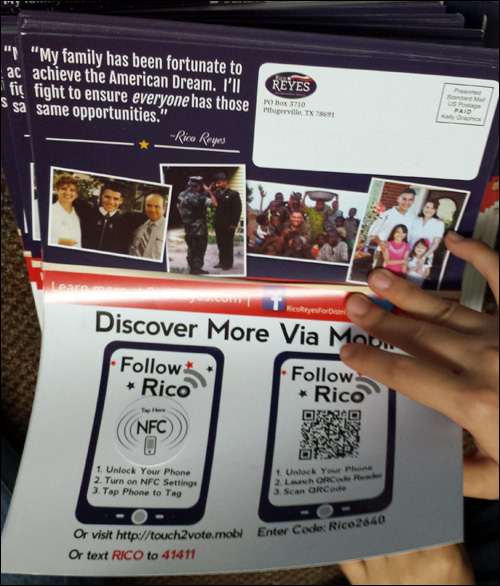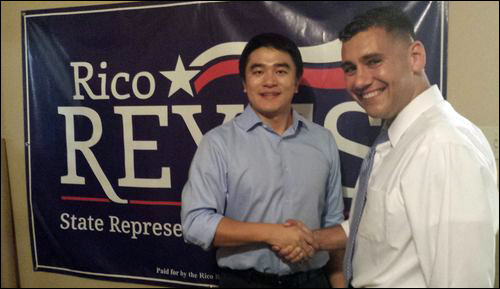Texas state representative hopeful Rico Reyes may be the first political candidate to reach out to voters via Near Field Communication (NFC) RFID technology. Reyes, a Democrat running for office in a special election race being held in District 50—which includes part of Austin and adjacent communities—recently mailed out 5,000 fliers, each with an NFC tag attached to each it, in the hope that recipients would engage with his campaign via the NFC readers built into their mobile phones. The stickers also enabled users to access information about the candidate, via typing in a URL, sending a text message or using a QR code. However, says Camilo Sandoval, the CEO of Camintel, which provided the technology for the deployment, the vast majority of respondents have been using their NFC readers to date, rather than the other options.
The one-time mailing was a pilot of Camintel’s Touch2Vote solution. When an individual taps an NFC-enabled phone against the mailer’s passive RFID tag, the Touch2Vote software provides that person with videos and other media about a candidate, as well as a means to send messages to that individual.
Camintel offered the system to New York City mayoral candidate Christine Quinn earlier this year, during the months leading up that city’s primary. In Quinn’s case, NFC RFID stickers would have been attached to posters. However, Sandoval says, due to New York City’s election regulations at the time, the solution was deemed unrealistic. Therefore, he says, he offered the technology to Reyes, in Texas.
District 50’s previous state representative, Mark Strama, resigned in late June to run Austin’s new Google Fiber project, which triggered an off-year special election to fill his vacant seat. Reyes faces a crowded race, and is looking to find new ways in which to engage voters who may not otherwise be following the election. Matt Glazer, Reyes’ campaign manager, believes his candidate has a compelling story to tell: Reyes earned law and MBA degrees prior to enlisting in the U.S. Marines, and then opted to work as a district attorney, with a focus on helping the community rather than maximizing his earnings. The candidate wanted to be able to share that story with those who received mailings, via a video, as well as hear from consitutents directly, explains Glazer, who owns digital data delivery company The Glazer Group. Reyes’ aim, Glazer says, was to reach potential voters via their mobile phones and social networks, such as Facebook and Twitter, or enable them to use the same technologies to send him questions.
According to Sandoval, the stickers—each containing an NFC RFID tag encoded with a unique ID number—could be applied to election posters, badges, fliers or mailers. Reyes opted to attach the stickers to mailers sent out to residents within the district. In total, the campaign office sent out 5,000 mailers last week, each with an RFID tag attached to one side of it. The mailers are printed with information about the candidate, as well as text explaining the Touch2Vote NFC system and other technology options.
Camintel applied stickers made with Smartrac BullsEye NFC tags to each of the 5,000 eight-by-11-inch mailers before they were taken to the post office. Camintel also created a digital record of each recipient’s address and tag ID. In that way, Camintel can provide the Reyes campaign with a map indicating in which areas the mailer gained the greatest or least amount of responses.
Users who received the mailers and wished to learn more about Reyes could tap their smartphone against the tag. The phone would then transmit that unique ID number to Camintel’s server, which, in turn, prompted a display of a 60-second video about the candidate on the phone’s screen. Users did not need to download special software, Sandoval says. “We try to develop experiences that don’t require an app,” he states, since downloading an app adds a layer of hassle.
After the video finished playing, the screen transitioned to a text box inviting users to enter a message that would then be sent directly to Reyes. It also offered options to link to additional videos about the candidate, or to “like” him on Facebook or connect via Instagram or Twitter.
After users have had a few more weeks to respond, Camintel intends to provide a geofencing report indicating which neighborhoods generated the most responses. By late last week (about five days after the fliers were mailed), approximately 50 NFC tag reads had been recorded, while there were a much smaller number of responses (video views or other methods of accessing data) via QR code, SMS text message or URL input. Only a few mailer recipients took the time to send Reyes a message, Sandoval says.

Glazer says it is too soon to determine the full results of the pilot. However, he notes, “On a top-line level, I can say that it was worth doing—it was very valuable.” During a special election, he explains, there may be as few as 8,000 voters. Therefore, it can be helpful for Reyes’ campaign to reach even 100 constituents, and to provide them with a “deeper, richer” connection via video views and social networks.
Placing tags that could sustain being passed through the post office’s mechanical sorter proved challenging, Sandoval says, and the company had to ensure that the tag was slim enough to fit through the sorter without being pulled loose. The stickers did, in fact, survive the mailing well, he reports.
Now that he has demonstrated that the technology works, Sandoval hopes to offer a similar solution to other political figures as well. His goal, he adds, is to identify a partner to work with that could help provide the solution in large volume.
Camintel also offers its Touch2Like app for Android mobile phones. The app is designed specifically for do-it-yourself marketers, as well as users who want to write their own code for an NFC use case. For example, businesses can employ the app to set up a system in which individuals could tap their NFC-enabled smartphones against an RFID tag, in order to receive data or a link to a social network or other site selected by the business. So far, the firm reports, the free app has been downloaded around 15,000 times. Camintel used the Touch2Like platform, running on its own server, at a Honey Bunches of Oats-branded summer concert, to help Post Foods promote its cereals (see At Miami Concert, NFC RFID Helps Post Foods Market Its Products).


